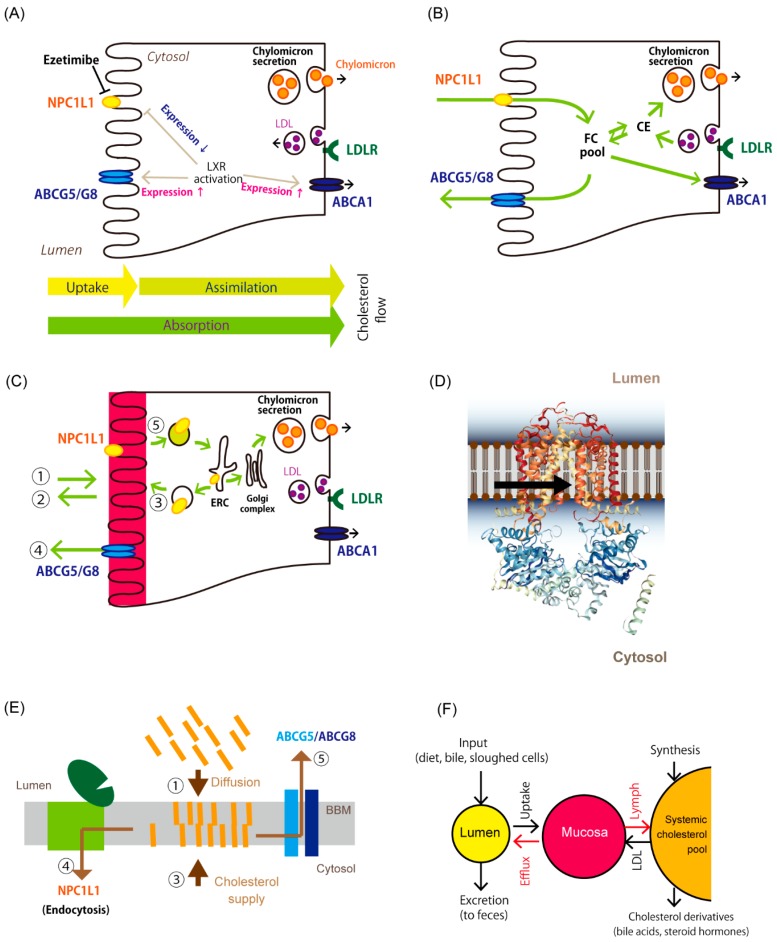Figure 1.
Overview of cholesterol trafficking in enterocytes. (A) Components associated with cholesterol absorption in enterocytes. Niemann-Pick C1-like 1 (NPC1L1) is the major cholesterol transporter. ATP-binding cassette (ABC) G5/G8 is an efflux transporter of sterols in the brush border membrane (BBM). Liver X receptor (LXR) modulates gene expression, the products of which are associated with the fluxes. Enterocytes take up cholesterol as low-density lipoprotein (LDL) via LDL receptor-mediated endocytosis from the basolateral side [19]. Cholesterol in enterocytes exists mainly as chylomicrons or very low-density lipoprotein (VLDL) [20]. These lipoproteins carry triacylglycerol predominantly and other lipids as well, but the figures do not show them for simplicity. Cholesterol is also transported into the serosal side to build high-density lipoprotein via ATP-binding cassette A1 (ABCA1). Arrows indicate up-regulation. Gene expression of NPC1L1 is attenuated by LXR activation. The terms of “uptake”, “assimilation”, and “absorption” are defined in the text. Ezetimibe is an NPC1L1 inhibitor. (B) A current image about how cholesterol transits in enterocytes. Cholesterol in the lumen passes through the membrane via NPC1L1. ABCG5/G8 effluxes free (nonesterified) cholesterol (FC) in the cytosolic area. CE, cholesteryl ester. (C) A newly proposed model for cholesterol movement in enterocytes. The BBM constitutes a large reservoir for free cholesterol (colored in red), which enters from and exists to the lumen in a diffusive manner (pathways 1 and 2). Cholesterol originating from de novo synthesis or the circulation is supplied to the BBM via vesicular transport (pathway 3). ABCG5/G8 effluxes cholesterol to maintain its abundance using energy from ATP hydrolysis (pathway 4). Cholesterol in the BBM moves to endocytic recycling compartments (ERC) via NPC1L1-mediated vesicular trafficking (pathway 5), then the Golgi complex, and packed into chylomicrons to be secreted into the circulation. (D) Topology of ABCG5/G8 and its cholesterol reception for transport. The resolved crystal structure of ABCG5/G8 showed that it is likely to obtain substrates from transmembrane site [21]. A three-dimensional image of ABCG5/G8 was obtained from the Orientations of Proteins in Membranes (OPM) database (http://opm.phar.umich.edu/protein.php?search=5do7). (E) ABCG5/G8 and NPC1L1 coordinate bidirectional cholesterol fluxes from the BBM. The BBM receives cholesterol from internal and external sources. NPC1L1 is endocytosed with membrane cholesterol in a regulated manner [22,23]. ABCG5/G8 effluxes excess sterols from the BBM. (F) A simplified open compartment model for cholesterol pools in the body (for details, see [5,20,24]). Circles indicate cholesterol pools in the body: Lumen, cholesterol in the intestinal tract; Mucosa reserves predominant cholesterol in the intestinal BBM. Arrows in red show cholesterol fluxes mediated by ABCG5/G8 and NPC1L1 for efflux and the basolateral cholesterol secretion (Figure 1E), respectively. Epithelial cell sloughing/shedding and nontransporter-mediated efflux (Figure 1C, pathway 2) also mediate mucosa-to-lumen cholesterol transition. The functionality of these transporters plays a crucial role in the net fluxes of cholesterol from the mucosa.

